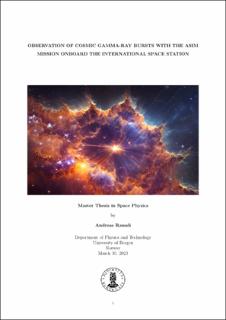OBSERVATION OF COSMIC GAMMA-RAY BURSTS WITH THE ASIM MISSION ONBOARD THE INTERNATIONAL SPACE STATION
Master thesis
Permanent lenke
https://hdl.handle.net/11250/3069685Utgivelsesdato
2023-03-30Metadata
Vis full innførselSamlinger
- Master theses [159]
Sammendrag
In this master's thesis, I systematically explored cosmic gamma-ray bursts (GRBs) detected by the ASIM instrument for the first time. Between June 1st, 2018 and December 31st, 2021, I identified 12 verified bursts. The case study section highlights two peculiar bursts: GRB 210619B, believed to originate from a distant dwarf galaxy, and GRB 211211A, which is thought to result from the merger of two compact objects. I developed an architecture for extracting ASIM spectra and streamlined the data preparation process using the ASIM Fits program. Additionally, I extracted Fermi spectra for relevant bursts and performed joint spectral analysis of ASIM, KW, and Fermi spectra for a subset of the 12 verified bursts. This thesis presents crucial information about the joint spectral analysis, while Appendix A features the folded and unfolded models for the relevant GRBs. This work expands the scientific impact of ASIM in directions divergent from the primary mission goals, building upon the foundation laid by the magnetar flare paper Castro-Tirado et al. (2021). The current work will be compiled into a paper, submitted to an Astrophysics journal in collaboration with international partners. Regarding future work and outlook, efforts have commenced to examine the mass model and cross-check it with the full CAD model of ASIM in order to enhance response matrices in regions where inconsistencies were detected. The analysis of the identified GRB sample will be expanded to include the calculation of duration (T90, T50) and the distribution of ASIM GRBs with respect to the available GRB catalog. The hypothesis is that ASIM detects a low number of GRBs, but these are typically short, bright, and energetic, making them highly interesting for follow-up analysis. The expertise and code developed will be employed for future GRB analysis from ASIM, particularly as the new LIGO-VIRGO gravitational waves observing run commences in May 2023. A follow-up study of the timing properties of ASIM GRBs will be conducted, leveraging ASIM's excellent timing capabilities. Additionally, the team is studying a follow-up mission of ASIM called TOTEM, which will include a smaller version of MXGS with improved features. The expertise gained now will be utilized to establish a GRB data analysis pipeline for TOTEM.
